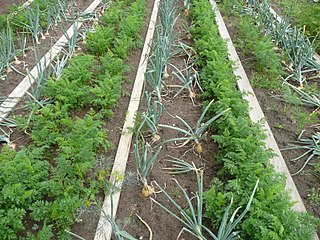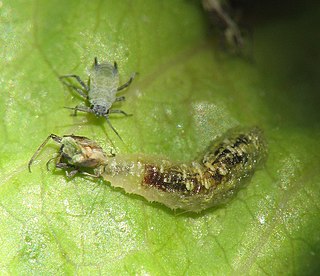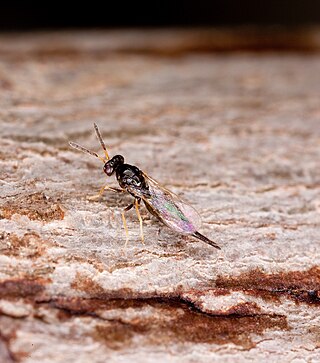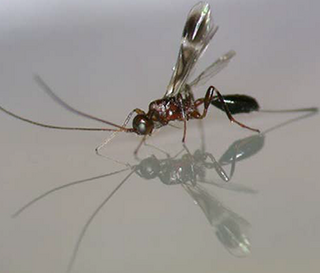Related Research Articles

Companion planting in gardening and agriculture is the planting of different crops in proximity for any of a number of different reasons, including weed suppression, pest control, pollination, providing habitat for beneficial insects, maximizing use of space, and to otherwise increase crop productivity. Companion planting is a form of polyculture.

Biological control or biocontrol is a method of controlling pests, whether pest animals such as insects and mites, weeds, or pathogens affecting animals or plants by using other organisms. It relies on predation, parasitism, herbivory, or other natural mechanisms, but typically also involves an active human management role. It can be an important component of integrated pest management (IPM) programs.

In evolutionary ecology, a parasitoid is an organism that lives in close association with its host at the host's expense, eventually resulting in the death of the host. Parasitoidism is one of six major evolutionary strategies within parasitism, distinguished by the fatal prognosis for the host, which makes the strategy close to predation.

The Tachinidae are a large and variable family of true flies within the insect order Diptera, with more than 8,200 known species and many more to be discovered. Over 1,300 species have been described in North America alone. Insects in this family commonly are called tachinid flies or simply tachinids. As far as is known, they all are protelean parasitoids, or occasionally parasites, of arthropods, usually other insects. The family is known from many habitats in all zoogeographical regions and is especially diverse in South America.

The Tiphiidae are a family of large, solitary wasps whose larvae are parasitoids of various beetle larvae, especially those in the superfamily Scarabaeoidea. Until recently, this family contained several additional subfamilies, but multiple studies have independently confirmed that these comprise a separate lineage, and are now classified in the family Thynnidae.

The Tephritidae are one of two fly families referred to as fruit flies, the other family being the Drosophilidae. The family Tephritidae does not include the biological model organisms of the genus Drosophila, which is often called the "common fruit fly". Nearly 5,000 described species of tephritid fruit fly are categorized in almost 500 genera of the Tephritidae. Description, recategorization, and genetic analyses are constantly changing the taxonomy of this family. To distinguish them from the Drosophilidae, the Tephritidae are sometimes called peacock flies, in reference to their elaborate and colorful markings. The name comes from the Greek τεφρος, tephros, meaning "ash grey". They are found in all the biogeographic realms.

Trichogramma is a genus of minute polyphagous wasps that are endoparasitoids of insect eggs. Trichogramma is one of around 80 genera from the family Trichogrammatidae, with over 200 species worldwide.

Parasitoid wasps are a large group of hymenopteran superfamilies, with all but the wood wasps (Orussoidea) being in the wasp-waisted Apocrita. As parasitoids, they lay their eggs on or in the bodies of other arthropods, sooner or later causing the death of these hosts. Different species specialise in hosts from different insect orders, most often Lepidoptera, though some select beetles, flies, or bugs; the spider wasps (Pompilidae) exclusively attack spiders.

A wasp is any insect of the narrow-waisted suborder Apocrita of the order Hymenoptera which is neither a bee nor an ant; this excludes the broad-waisted sawflies (Symphyta), which look somewhat like wasps, but are in a separate suborder. The wasps do not constitute a clade, a complete natural group with a single ancestor, as bees and ants are deeply nested within the wasps, having evolved from wasp ancestors. Wasps that are members of the clade Aculeata can sting their prey.

Encarsia is a large genus of minute parasitic wasps of the family Aphelinidae. The genus is very diverse with currently about 400 described species and worldwide distribution. The number of existing species is expected to be several times higher because many species are still undescribed. Encarsia is a very complex genus, with specimens showing both inter- and intra-specific variations, making morphological classification difficult.

Trigonospila brevifacies is a species of true fly in the family Tachinidae native to eastern Australia. This species is also found in New Zealand. Like the vast majority of tachinid flies, T. brevifacies is a parasitoid of other insects, specifically late larval stages of a number of species of Lepidoptera. It is also known as the Australian Leaf-Roller Fly or Leafroller Fly.

Cyzenis albicans is a species of fly in the family Tachinidae. A parasitoid, it lays its eggs on leaves of oak, maple, birch and other trees, so that when the leaves are consumed by the larvae of the host winter moth, the eggs hatch inside the larvae. The fly is native to Europe and Asia but has been introduced into North America as a biological control agent of the invasive winter moth.

Tetrastichus planipennisi is a parasitic non-stinging wasp of the family Eulophidae which is native to North Asia. It is a parasitoid of the emerald ash borer, an invasive species which has destroyed tens of millions of ash trees in its introduced range in North America. As part of the campaign against the emerald ash borer (EAB), American scientists in conjunction with the Chinese Academy of Forestry searched since 2003 for its natural enemies in the wild leading to the discovery of several parasitoid wasps, including Tetrastichus planipennisi which is a gregarious endoparasitoid of EAB larvae on Manchurian Ash and has been recorded to attack and kill up to 50 percent of EAB larvae.

Spathius agrili is a parasitic non-stinging wasp of family Braconidae which is native to North Asia. It is a parasitoid of the emerald ash borer, an invasive species which has destroyed tens of millions of ash trees in its introduced range in North America. As part of the campaign against the emerald ash borer (EAB), American scientists in conjunction with the Chinese Academy of Forestry began searching in 2003 for its natural enemies in the wild, leading to the discovery of several parasitoid wasp species, including Spathius agrili. S. agrili was discovered in Tianjin, China where it is a prevalent parasitoid of EAB larvae in stands of an introduced ash species, and an endemic ash species. S. agrili has been recorded to attack and kill up to 90 percent of EAB larvae.

Cotesia is a genus of braconid wasps first described by Peter Cameron in 1891. Some species parasitize caterpillars of species considered pests, and are used as biocontrol agents. Cotesia congregata parasitizes the tomato and the tobacco hornworms. C. glomerata and C. rubecula feed on the cabbage white and other white butterfly caterpillars. C. gonopterygis and C. risilis are host-specific and parasitize the common brimstone.
Trichogramma japonicum is a minute wasp parasitoid from the Trichogrammatidae family in the order Hymenoptera. T. japonicum parasitizes the eggs of many pest species, especially Lepidoptera found in many monocultures. They are entomophagous parasitoids that deposit their eggs inside the host species' egg, consuming the host egg material and emerging from the egg once development is complete. T. japonicum can be found naturally in rice ecosystems, but are dispersed commercially to many monocultures as a biological control. The mitochondrial genomes of T. japonicum are significantly rearranged when comparing it to related insects.

Agrypon flaveolatum is a species of parasitoid wasp belonging to the family Ichneumonidae described by Johann Ludwig Christian Gravenhorst in 1807. It is a parasite of the larva of the winter moth, and has been used in biological pest control to control this moth, whose larvae feed on foliage and defoliate trees.
Seirian Sumner FRES is a British entomologist and behavioural ecologist. She is a professor at University College London and is an expert in social wasps.
George Salt was an English entomologist and ecologist. He was elected a Fellow of the Royal Society in 1956.
Barbara Ingeborg Patricia Barratt is a New Zealand entomologist and biocontrol expert. In 2022, she was elected as fellow of the Royal Society Te Apārangi.
References
- 1 2 "Dr Luke Tilley". Royal Entomological Society. 21 July 2017. Retrieved 15 August 2020.
- ↑ "20th June 2016 – Luke Tilley, Royal Entomological Society". Biotweeps. 19 June 2016. Retrieved 16 August 2020.
- ↑ Durose, Katie (14 April 2012). "Nantwich man to lead national insect campaign". Winsford and Middlewich Guardian. Retrieved 17 September 2020.
- ↑ "STC Stengthens[sic] it's Science Team". stockbridgeonline.co.uk. Stockbridge Technology Centre. Retrieved 17 September 2020.
- ↑ "Assessing the prospects for biological control of the shore fly, scatella tenuicosta, by the parasitoid, aphaereta debilitata, in glasshouse horticulture". ethos.bl.uk. British Library. Retrieved 16 September 2020.
- 1 2 "20th June 2016 – Luke Tilley, Royal Entomological Society". biotweep.wordpress.com. 19 June 2016. Retrieved 16 September 2020.
- ↑ "Dr Luke Tilley FRES". Royal Entomological Society. Royal Entomological Society. 21 July 2017. Retrieved 15 September 2021.
- ↑ Tilley, Luke (2011). "Testing a candidate parasitoid in the glasshouse: control efficacy of Aphaereta debilitata (Hymenoptera: Braconidae) against shore fly populations". Biocontrol. 56 (6): 851–860. doi:10.1007/s10526-011-9362-x. S2CID 9931046.
- ↑ Tilley, Luke (2011). "Control of a glasshouse pest through the conservation of its natural enemies? An evaluation of apparently naturally controlled shore fly populations". Biological Control. 56: 22–29. doi:10.1016/j.biocontrol.2010.09.003.
- ↑ George, David (2013). "Control of a glasshouse pest through the conservation of its natural enemies? An evaluation of apparently naturally controlled shore fly populations". Biological Control. 67: 539–547. doi:10.1016/j.biocontrol.2013.08.013.
- ↑ Dicks, Lynn (2012). "Identifying key knowledge needs for evidence‐based conservation of wild insect pollinators: a collaborative cross‐sectoral exercise". Insect Conservation and Diversity. 6: 435–446. doi:10.1016/j.biocontrol.2013.08.013.
- ↑ Bawden, Tom (26 June 2020). "From honeybees to dragonflies and spittlebugs, interest in insects has soared — and there's 24,000 species in the UK". iNews. Retrieved 17 September 2020.
- ↑ Hill, Emma (12 July 2018). "The results are in! The Great Bug Hunt 2018". ase.org.uk. Retrieved 17 September 2020.
- ↑ "INSTAR magazine". nationalinsectweek.co.uk. Royal Entomological Society. Retrieved 17 September 2020.
- ↑ "ICE Symposia | ICE 2016 XXV International Congress of Entomology". Insects and the Public: Engagement, Education and Outreach. Archived from the original on 9 August 2020. Retrieved 17 August 2020.
- ↑ "Royal Entomological Society". Guinness World Records. Retrieved 17 August 2020.
- ↑ Tilley, Luke. "Insects - little things that run the world" (PDF). naee.org.uk. National Association of Environmental Education. Retrieved 17 September 2020.
- ↑ "13th Annual Conference of the British Society of Literature and Science". brookes.ac.uk. Retrieved 17 September 2020.